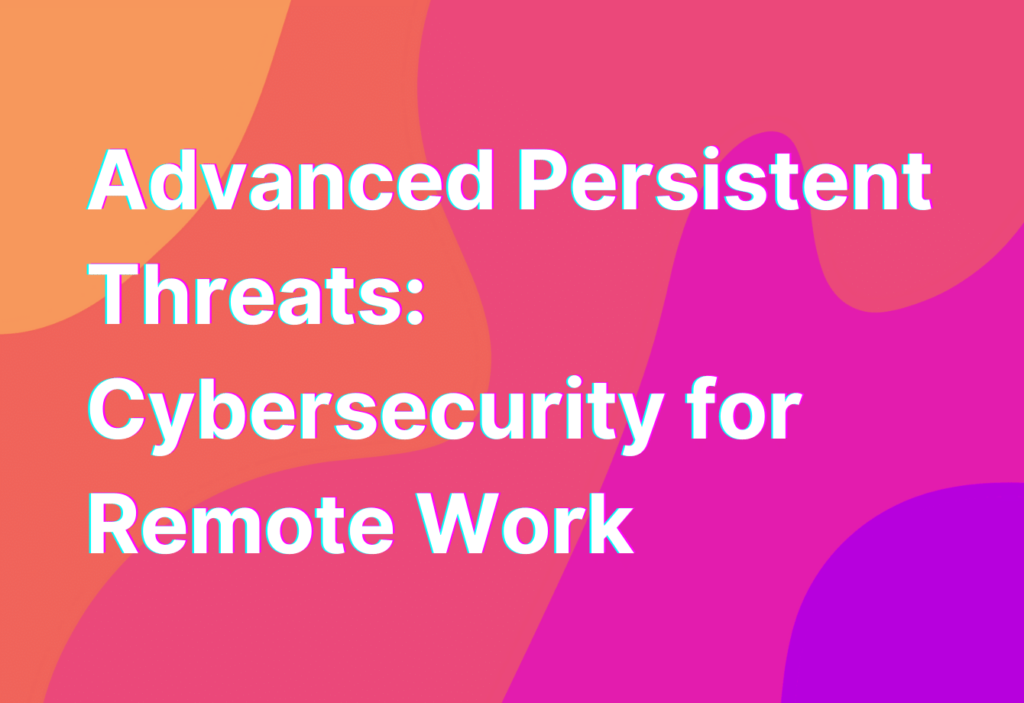Advanced Persistent Threats: Cybersecurity for Remote Work
Hey there, remote work warriors! It’s Ashley, your friendly neighborhood remote work advocate, back with another informative blog post. Today, we’re diving into the world of cybersecurity and exploring the ever-present threat of advanced persistent threats (APT) in the remote work landscape. So grab your favorite cup of coffee and let’s get started!
What are Advanced Persistent Threats?
Before we delve into the nitty-gritty details, let’s make sure we’re all on the same page. An advanced persistent threat (APT) is a sophisticated cyber attack that targets a specific organization or individual over an extended period of time. These threats are not your run-of-the-mill malware or phishing attempts; they are highly targeted and often carried out by skilled hackers or state-sponsored groups.
Now, you might be wondering, “Ashley, why should I be concerned about APTs as a remote worker?” Well, my friend, the answer lies in the nature of remote work itself. When you work remotely, you’re often accessing company resources and sensitive information from outside the traditional office environment. This opens up a whole new world of vulnerabilities that cybercriminals can exploit.
The Risks of APTs for Remote Workers
So, what exactly are the risks of APTs for remote workers? Let me break it down for you:
- Data Breaches: A successful APT can result in a massive data breach, exposing sensitive company information, customer data, and even personal details of employees. This can have severe consequences for both the organization and the individuals involved.
- Financial Loss: APTs can lead to significant financial losses for organizations, including the costs associated with investigating the breach, implementing security measures, and potential legal actions.
- Reputation Damage: A high-profile APT can tarnish an organization’s reputation, eroding customer trust and loyalty. This can have long-lasting effects on the company’s bottom line.
- Intellectual Property Theft: APTs often target valuable intellectual property, such as trade secrets, patents, and proprietary technology. The theft of such assets can cripple a company’s competitive advantage.
- Disruption of Operations: In some cases, APTs aim to disrupt an organization’s operations, causing chaos and financial harm. This can include shutting down critical systems, sabotaging processes, or spreading misinformation.
Now that we understand the risks, let’s talk about how we can protect ourselves from these persistent threats.
Protecting Yourself from APTs
When it comes to cybersecurity, prevention is key. Here are some essential steps you can take to protect yourself from APTs:
- Use Strong and Unique Passwords: I know, I know, we’ve all heard this a million times, but it’s worth repeating. Using strong and unique passwords for all your accounts is the first line of defense against APTs. Consider using a password manager to keep track of your passwords securely.
- Enable Two-Factor Authentication (2FA): Adding an extra layer of security with 2FA can significantly reduce the risk of unauthorized access to your accounts. It’s like having a bouncer at the door of your virtual party!
- Keep Your Software Updated: Regularly updating your operating system, applications, and antivirus software is crucial for staying protected against the latest APTs. Those updates often contain important security patches that can make all the difference.
- Be Wary of Phishing Attempts: APTs often start with a well-crafted phishing email or message. Be vigilant and double-check the sender’s email address, links, and attachments before clicking on anything suspicious. When in doubt, don’t click!
- Invest in a Reliable VPN: A virtual private network (VPN) can encrypt your internet connection, making it harder for cybercriminals to intercept your data. It’s like wearing an invisibility cloak while browsing the web!
These are just a few of the many steps you can take to protect yourself from APTs. Remember, cybersecurity is an ongoing process, and staying informed about the latest threats and best practices is essential.
Wrapping Up
Well, folks, we’ve reached the end of our cybersecurity journey. We’ve explored the world of advanced persistent threats (APT) and learned how they pose a significant risk to remote workers. But fear not! By following best practices, staying vigilant, and investing in robust security measures, we can protect ourselves from these persistent threats.
Before I sign off, I want to leave you with one last resource to further enhance your remote work security: Bot Security for Remote Work: Key Insights. This comprehensive guide dives deep into the world of bot security and provides valuable insights to keep your remote work environment safe and sound.
Stay safe, stay secure, and keep rocking that remote work life!


